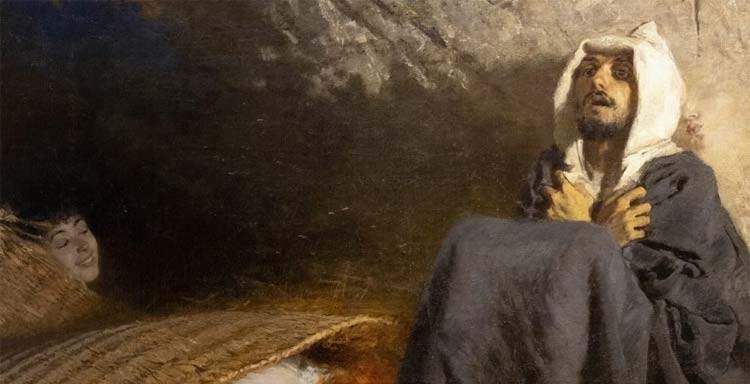On Monday, Nov. 21, the National Gallery of Modern and Contemporary Art opened the exhibition Domenico Morelli. Imagining Things Not Seen, curated by Chiara Stefani with Luisa Martorelli.
“Morelli was as the true artist must be, that is, he knew what he did not know, and he saw what he had never seen.” This is how the painter Eduardo Dalbono remembered him shortly after his death, evoking The Temptations of St. Anthony as a masterful example of the artist’s “intuitive and divinatory” faculties. Almost seventy years after the Exhibition of Drawings set up in 1955 by Palma Bucarelli at Valle Giulia, Domenico Morelli (Naples, 1823 - 1901) returns to prominence in the Via Gramsci rooms of the National Gallery, as he had already been, in 1907. The collection consisting of graphic works, cartoons, sketches and paintings remaining in the artist’s atelier at his death and purchased by the state had just been transferred from Naples to Rome: Francesco Jacovacci, then director of the Galleria Nazionale d’Arte Moderna, had partially set it up inside four rooms of the Palazzo delle Belle Arti on Via Nazionale.

The exhibition is an opportunity to see a large part of the artist’s very rich and heterogeneous collection along with works also from other public institutions or private collections, with theexhibition of about 30 paintings and 9 sketches, 9 sculptures, a corpus of 48 oil on wood tablets with landscape paintings made in the coast south of Naples, a large mixed media cartoon and a conspicuous selection of 160 works on paper, among the more than 800 sheets belonging to the Morelli fund preserved by the National Gallery.
The gestation of Domenico Morelli’s paintings is a process of continuous rethinking of compositional solutions devised after a careful study of the Real, the individual elements of which are analyzed several times before reaching the version deemed optimal. While the range of techniques employed by the artist on paper ranges from the use of graphite, charcoal, sanguine and pastel-accompanied in various cases by white lead highlights, as well as by thebrown ink, often copiously watercolored - to watercolor and tempera in various shades, sometimes over traces of pencil, the sketches undo in color the careful graphic study of each sheet preparatory to them.
For the first time since the beginning of the last century, the canvas of the unfinished painting The Troubadour among the Nuns, coveted at the time by the French merchant Jean-Baptiste Michel Adolphe Goupil and the subject of a special conservation intervention by the students of the Central Institute for Restoration, is shown to the public. After cleaning, the precious frames of the paintings appear in the variety of their techniques: carved and decorated with pure gold leaf and mecha silver, to which had been added, in one particular case, the application of a strip of fabric on the wooden surface.
A series of sculptures in marble, bronze and terracotta by artists of the period-such as Alfonso Balzico, Adriano Cecioni, Giovanni Focardi, Giacomo Ginotti, Achille D’Orsi, Vincenzo Gemito, Domenico Trentacoste, Giuseppe Renda, and Mario Rutelli-are related to Morelli’s paintings, attesting to their influence in some cases. Various works on canvas by other painters - Gioacchino Toma, Eduardo Dalbono, Achille Talarico, Gaetano Previati, Paolo Vetri -, and a pastel by Francesco Paolo Michetti, dialogue with Morelli’s compositional solutions. Dalbono’s painting The Legend of the Sirens is exhibited for the first time alongside the replica from a private collection, which features an interesting variation in the background palette.
From the psychological introspection of the portraits and figures drawn from European Romantic literature - Count Lara, Lady Godiva, Torquato Tasso reading Gerusalemme Liberata to Eleonora d’Este - to the suffered meditations on motifs related to the Christian religion - The Obsessed, The Corpse of Saint Mary Egyptian Found by Angels, and The Monks (or Good Friday) -, Morelli moves on to the airy compositions shrouded in an aura of silent mystery of the canvases of the last decade of the 19th century: Christ in the Desert, Pater Noster (or The Sermon on the Mount) and The Loves of Angels. Meanwhile, the increasingly painterly solutions of some of the graphic works document how his gaze progressively turned toward theEast-where Morelli never traveled-demonstrating a particular interest in its customs and practices related to the Muslim religion.
The painting with theEmbalming of Christ anticipates, towards the end of the seventh decade of the nineteenth century, the arid and desolate scenarios of The Maries Watching the Crucifixion of Jesus from afar (c. 1898), the Judas sees Christ Arrested in Gethsemane (1900), and Christ Watching the Apostles (1900): metaphors of physical weakness and human loneliness, as well as prefigurations of a contemporary existential condition.
For all information, you can visit the official website of the National Gallery of Modern and Contemporary Art.
Pictured: Domenico Morelli, The Temptations of St. Anthony (1878).
 |
| Rome, at GNAM a major exhibition on Domenico Morelli, among the greatest painters of the 19th century |
Warning: the translation into English of the original Italian article was created using automatic tools. We undertake to review all articles, but we do not guarantee the total absence of inaccuracies in the translation due to the program. You can find the original by clicking on the ITA button. If you find any mistake,please contact us.